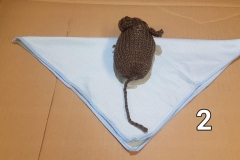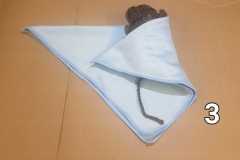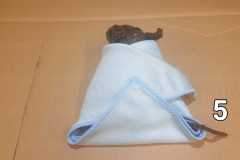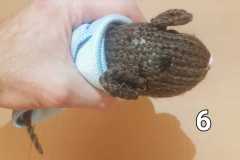The degu is a lively and very fast rodent. Catching and handling them can sometimes be challenging, whether for transporting them or recovering them after they escape. There are several ways to handle a degu. The most common and widely used method is for catching a rodent attempting to leave its cage. Handling a degu in its cage (if it’s skittish), recovering an escaped degu, or ensuring it remains under control (e.g., for feeding) are more complex and come with significant biting risks. In general, it’s important to let the animal come to you as much as possible and get it accustomed to climbing onto your hands to minimize stress.
Catching a degu that wants to leave the cage or climb onto your hands
This is the gentlest method for catching a degu. All you need to do is place your hands, cupped, on either side of the degu and let it climb as you close the cup. If necessary, you can hold the base of the tail to prevent it from jumping. A properly tamed degu should allow this without any problems or biting. If your degu doesn’t come on its own or is afraid, you’ll need to first get it used to climbing onto your hands.
Video À Propos Octodons
Emergency Handling
Emergency handling is useful if you need to catch a non-compliant degu. However, these procedures should be performed calmly to limit stress on the rodent.
Recovering an escaped Degu

If your degu has escaped and hidden, there are several ways to recover it without engaging in a frenzied chase (which could lead to losing the rodent). First, block all possible exits, especially if you’re unsure of the room where the escapee is. Close doors, and toilet lids, and seal potential pathways to holes or other escape routes. Place some treats in each room, preferably along a wall and not in the center of open spaces. A stressed degu will tend to stay close to a potential shelter and avoid exposing itself to predators. If you have other animals like dogs or cats, keep them away from where you’re sure there’s no escaped degu.
Once you’ve identified the room, try to remove as many hiding places for the degu as possible, to prevent it from staying in one spot. With a box or a large container, create a “trap” along one of the walls. Position the container to create a shelter where the degu can enter, along with food at the end. Then wait quietly for the escapee to show itself, and encourage it with treats. When it enters the box, tip it to close the opening and place a lid on it. You can then safely return your rodent to its cage.
Catching a Degu in Its Cage
It is sometimes necessary to catch a degu inside its cage to check its health or take it to the veterinarian. This can be very stressful for the animal, and there is a risk of biting for some degus. You can reuse the box method by placing a transport box with treats inside the cage and closing the lid at the right moment.
The other option is to use the cupped hands method to catch the degu from a corner of the cage. It’s often easier to remove hideouts and wheels. Be cautious; if the degu feels too cornered, it may bite.
Video À Propos Octodons
Containing a Degu
When providing care to a degu, it’s essential to know how to handle it properly. You may need a small towel to wrap the degu, a method referred to as “burrito,” which involves containing the degu in a fabric to provide it with necessary care, such as feeding through a dropper.
To do this, you should place the degu at the center of the towel, folded in half in the shape of a triangle, and fold each corner over the animal. This allows you to hold it gently to provide the necessary care. Note that this method should only be used when needed and not for daily handling of the degu.
Thanks to DeguMania for the images.
Never Grab a Degu by the Tail
Under no circumstances should you grab or carry a degu by the tail. The tail is fragile and can break very easily, similar to the tail of a lizard01. It will not grow back, and amputation may be necessary. You can secure a degu’s hold in your hand by placing your thumb at the base of the tail to stabilize it. However, never hold or pull the tail, as it is very fragile and can break.






